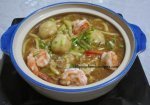- Home
- Filipino Ingredients
Filipino Ingredients
Filipino ingredients are the basis for authentic Filipino cooking.
So what are the Filipino pantry essentials?
Any Filipino can easily enumerate Rice, Pancit (rice noodles), Bagoong (shrimp paste) and Patis (fish sauce) for starters...
Let's take a look into the pantry of a typical Filipino household...
...starting with the backbone...
RICE

There are, basically, 2 different kinds of rice used in Filipino ingredients and they are White Rice and Glutinous or Sweet Rice.
WHITE RICE
A staple in the Filipino diet … Most Filipinos will tell you that a meal is not a meal unless it is served with rice. Rice complements the main course dishes of meat, seafood and even vegetables.
Interestingly, it's not just any kind of rice. We prefer it white as snow, long-grain and aromatic.
Jasmine or Milagrosa is the favorite. The texture is a little sticky and you will know if it's a new crop because of it's strong aroma. The rice loses it's aroma with time, but you can use Pandan or Screwpine leaves to give you the same result. Pandan leaves are commercially available frozen in some Asian markets.
Learn more about COOKING RICE, THE FILIPINO WAY.
GLUTINOUS RICE OR SWEET RICE
Glutinous, also called sweet rice is a short-grain rice that's starchy and sticky when cooked. It's used for savory dishes like Arroz Caldo and Bringhe and for sweet desserts like Biko, Champorado,Guinataang Monggo and Ginataang Mais.
When soaked in water and ground-up, Glutinous rice turns into a type of dough called Galapong. Galapong is used to make Puto, Palitaw,Bibingka.
Learn HOW TO MAKE GALAPONG OR SWEET / GLUTINOUS RICE DOUGH.
FLOURS AND STARCHES
Flour, in most Filipino food recipes, is used more like starches, as a thickening agent to make a slurry rather than for baking, and mainly because not many Filipino households bake their own breads and cakes.
If you enjoy baking and you would like to keep some baking flour on hand in your Filipino pantry, I suggest that you check the recipe to see what type of flour it specifically calls for, such as self-rising flour or whole wheat flour, to name just a couple.
The various kinds of flour each have a different structure that can affect the texture of the final product, so try your best to get the exact kind of flour the recipe calls for...especially when you're making it the first time.
The most common flours and starches found in the typical Filipino pantry are:
- all-purpose
- cornstarch
- tapioca - though not a common ingredient, it is great for thinner sauces
BENG'S TIPS
- It is extremely important to remember that you should never put a thickener straight into a sauce without dissolving it first, or you will get lumps in your sauce...
- When using Cornstarch or Tapioca starch, make sure to dissolve them in cold water.
- BUT, when using All-purpose flour, DO NOT use water, because flour does not completely dissolve in water. Instead, I recommend that you mix it in a little oil, or make a roux (heat up oil and add the flour until it's totally dissolved and cook for a minute).
NOODLES AND PASTA
NOODLES
Noodles symbolize long life - we learned that from the Chinese, so noodles are one of the 'must-have' Filipino ingredients prepared during Birthdays and Holidays.
The most popular Filipino noodle dish is the Pancit Bihon Guisado, which is made from rice flour - a thin white string noodle that turns transparent when soaked.
PASTA
Typically, Filipinos are not very fond of making their own fresh pasta from scratch. I, myself, have yet to see a Filipino who does. In my family, we grew up on dried pasta bought from supermarkets in the Philippines.
The most popular varieties of pasta found in most Filipino pantries are:
- Spaghetti
- Macaroni
- Fettuccine
- Lasagna
SEASONINGS, SPICES AND HERBS
Dry Seasonings:
- Salt
- Pepper
- Peppercorns
- Bay Leaf or Laurel leaf
- anise seed
- achuete, Chili
- Pepper Flakes
- Curry Powder
- Saffron (Kasubha)
- Oregano
Wet Seasonings:
- Fish Sauce (Patis)
- Soy Sauce (Toyo)
- White Cane Vinegar (Suka)
- Shrimp Paste (Bagoong)
- Banana Catsup or Tomato Ketchup
FILIPINO INGREDIENTS FOR DESSERTS AND BAKING
- Sugar
- Refined White
- Confectioner's
- Brown (Dark and Light)
- Yeast
- Active-Dry
- Instant
- Rapid-rise
- Milk
- Condensed
- Evaporated
- Whole Milk
- Skim Milk in liquid or powdered form
- Baking Powder
- Baking Soda
- Cocoa Powder
- Dessicated Coconut
- Vanilla extract
Knowing your Filipino ingredients, their uses and taste profiles and familiarizing yourself with their Tagalog and English terms is essentially the first step in learning how to cook Filipino.
Return to Home Page
Return to Filipino Ingredients Top page


